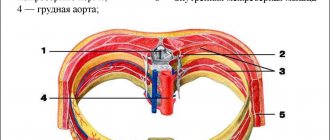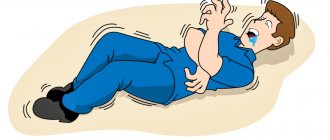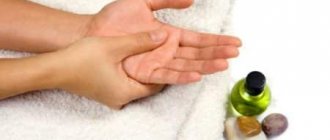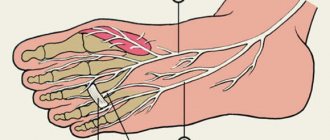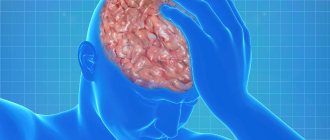Leg cramps most often occur at night. They may be episodic or repeated with a certain frequency. With occasional seizures, as a rule, there is no cause for concern. Frequent seizures may indicate certain pathological conditions. With the clonic type of cramps, the muscles quickly contract and relax. The tonic variety is characterized by prolonged muscle tension. Both varieties are accompanied by some infectious diseases, intoxication, poisoning, traumatic brain injury, neurosis, metabolic disorders, heart disease, blood disease, deficiency of vitamins and microelements.
Causes of seizures
The cause of cramps is muscle fatigue, nervous tension, monotonous sedentary work, prolonged walking or swimming, dehydration, and various diseases. The appearance of sudden, “unplanned” muscle contractions at night most often occurs due to a malfunction of calcium channels. For muscle contraction, sodium, potassium and magnesium cations are needed. Each of them plays a role:
- Sodium
– provides resting potential; - Potassium
– stimulates cell excitation; - Magnesium
– changes the period of contraction to the resting stage.
Calcium ions are directly involved in the process, without which not only muscle contraction, but also the vital activity of the body is impossible. During wakefulness, calcium cations are used for muscle function; during sleep, they are normally deposited in bone tissue depots.
With increased tension in the muscular system, cramps occur at night, mainly in the legs. First in the shins, then throughout the leg. If a person works more with his hands, the fingers become numb, the palms feel tingling, and then spastic contractions occur. This is how contractures are formed - persistent muscle contractions that impair functions: writer's cramp, obstetrician's hand.
Cramps are caused by club feet
A common cause of muscle spasms in the calves is clubfoot, which is when the heel tilts inward and causes a twist in the ankle joint. The defect is especially noticeable in high-heeled shoes. Over time, the legs begin to quickly get tired, they feel heavy, the calves and knees hurt, and the veins of the feet and legs become dilated. At night, my legs go numb, cold, and cramps occur. “Spurs” may form and posture may worsen.
Leg cramps at night with polyneuritis
With polyneuritis, the nerves are affected. The cause is viral diseases, intoxication, hypovitaminosis, metabolic disorders in diabetes mellitus. The disease is accompanied by nighttime leg cramps, tingling, goosebumps, and sometimes numbness are felt on the skin. The head hurts or feels dizzy, hearing decreases, discomfort is felt in the cardiac region, and irritability increases.
Leg cramps with varicose veins and thrombophlebitis
With varicose veins, veins expand, reaching a significant diameter. The disease occurs when the venous valves weaken, causing the blood to stagnate excessively and stretch the walls of the veins. A common cause is a sedentary lifestyle, hereditary predisposition, slagging of the body, causing weakening of the walls, reduced fluid circulation due to excess weight or pregnancy, a consequence of hormonal changes, taking birth control pills, prolonged daily standing.
The calves swell, causing night cramps. The skin may peel off from your legs, they hurt, itch, and you constantly feel tired. To stimulate circulation and prevent night cramps, it is worth giving your legs physical activity and taking walks. Special elastic stockings shown. It is worth giving up a tight belt or belt, getting rid of the habit of sitting cross-legged, since in this position the outflow of venous blood worsens.
Stagnation of blood with varicose veins can cause thrombophlebitis, inflammation of the vein wall and its complete blockage. Often this complication of varicose veins, causing destruction of the venous valves, occurs during pregnancy. The body is rebuilt, the outflow of blood is disrupted due to compression of the venous plexuses by the uterus. Under the influence of hormones, the walls of the veins soften and are damaged by sudden changes in pressure inside the vessels during labor.
The cause of leg cramps during pregnancy is venous insufficiency. In the evening, the feet and legs swell, the calf muscles feel heaviness, and convulsive contractions occur at night. If the veins are accidentally injured, a bruise will form. In the later stages, the veins of the lower legs, thighs, and perineum expand, which can cause heavy bleeding during childbirth.
Night leg muscle cramps with hypoparathyroidism
The parathyroid glands are located near the neck in close proximity to the thyroid gland. They regulate phosphoric acid metabolism in the body. Sometimes the lack of function is caused by their damage during surgery on the thyroid gland. Signs of hypoparathyroidism are manifested by muscle spasms, including respiratory muscles, cramps of the feet, and fingers. The stomach hurts, the stool is loose, and sometimes allergies appear. Everything around you begins to irritate you for no reason, nervous breakdowns occur, and sleep deteriorates.
The cause of painful, repeated cramps in the calf muscles is a lack of calcium caused by hypoparathyroidism. Calcium is found in milk powder, cheese, soy, nuts, cabbage, parsley, cream, yogurt, beans, and cottage cheese. The daily requirement is 1000-1500 mcg. Deficiency is manifested by brittle nails, decreased resistance to disease, deterioration of memory, and blood clotting. Calcium is especially necessary for dieters, during pregnancy, and during teenage development.
If the cause of seizures is associated with hypoparathyroidism, treatment requires vitamin D, which promotes the absorption of calcium and phosphorus, regulating the exchange of these elements. Vitamin D is rich in fish oil, cod liver, herring, tuna, cheese, cottage cheese.
The cause of night cramps is hemorrhoids
With a sedentary lifestyle, constipation, and heavy lifting, the veins of the rectum expand and become pinched. The disease develops when there is a deficiency in the diet of magnesium, vitamins C, K, and R. If pain or bleeding occurs during bowel movements, leg cramps, or bruises on the body, it is necessary to eliminate magnesium deficiency. Magnesium is found in wheat bran, sunflower seeds, pumpkin seeds, nuts, soybeans, and lentils. Fresh vegetables and fruits, tomatoes, sweet peppers, dill, sorrel, lemons, oranges, black currants are rich in vitamin C.
Vitamin K is found in green plants, liver, walnuts, and cabbage. In addition, it is produced by intestinal microflora. If enough dietary fiber is supplied with the diet, the walls are not contaminated and the balance is not disturbed, the body receives a sufficient amount of vitamin K. Vitamin P is included in rose hips, red capsicums, oranges, grapes, and black currants.
Medicines that cause cramps at night
Diseases that have nothing to do with the mechanisms of muscle contraction indirectly influence the appearance of cramps at night. This occurs due to the use of medications prescribed to lower blood pressure and improve the functioning of the cardiovascular system. Many tablets for lowering blood pressure contain diuretic components, the mechanism of action of which involves the loss of potassium in the urine.
With a lack of potassium, the resting potential phase is unsecured, even with a normal content of magnesium cations. It turns out this way: magnesium “sends” calcium to the cellular storage, and the channel for sodium ions does not close. Muscle spasm continues, cramps occur at night, mainly in the morning when all adaptation mechanisms are exhausted.
The only diuretic that preserves potassium is veroshpiron, an analogue of vasopressin, a hormone of the anterior pituitary gland. All other drugs act at the level of the renal tubules, blocking the receptors responsible for the absorption of potassium from primary urine.
In addition, some drugs have a selective effect on certain receptors that are located in blood vessels, as well as in nervous and muscle tissue. Some patients taking alpha-blockers experience cramps at night, similar to restless legs syndrome. This is a manifestation of convulsive activity of the calf muscles.
Prevention
Eliminating bad habits: smoking, drinking alcohol and large amounts of coffee, salt, preservatives, significantly improves electrolyte balance and prevents the development of seizures.
Athletes and physical workers are advised to ensure that their daily diet is properly filled, to do warm-up exercises during prolonged work and warm-up exercises before training, and to get quality rest.
To prevent calf muscle cramps from happening again during sleep, eliminate the possibility of diseases that provoke muscle spasms.
Lead an active lifestyle and eat right. Check your health regularly.
First aid for cramps at night
When convulsions occur for the first time, a person may not even immediately understand what happened, because he has not experienced such pain before. In such a state, the main thing is to remain calm and follow the recommendations. As a rule, during cramps a person feels a burning, pulling or aching pain. There may also be numbness of the limb, a feeling of “goosebumps” on the skin, as well as complete loss of sensitivity in some areas of the legs (feet, calves, fingers).
It is important to know that an attack of convulsions in itself does not cause serious harm to the body’s systems, that is, it is not life-threatening. Typically, such attacks last from two to eight minutes, after which leg function is restored.
So, if seizures occur at night, you must:
- Sit on the bed and examine your leg.
- Pinch the tense muscle to relieve spasm.
- Intensely rub the area affected by the cramp to increase blood flow to it. You can do this using alcohol, which will also help warm the limb.
- Next, you should carefully stand up, do not make sudden movements (with a strong cramp, a person may simply not be able to stand on his feet).
- Without bending your knees, try to touch your fingers to the floor in order to stretch the cramped leg muscles.
- If it is difficult for a person to get out of bed, then the same exercise can be done while lying down, the main thing is to make your body “work” and relieve spasm.
- Next, you need to try to walk around the room a little, squat and even jump, thus dispersing the blood and restoring sensitivity in the legs.
- It is allowed to apply a warm compress to the place where the cramp occurred.
- After performing the exercises, you should lie down in bed and place your legs so that they are above the level of the pelvis. To do this, you can place elastic pillows or fabric bolsters under your knees and feet. This action will ensure normal blood circulation and relieve pain.
- For severe pain, you can take a mild analgesic (Paracetamol, Ibuprofen, etc.).
It is important to know that if a cramp does not go away for a long time, this can be a serious signal, because sometimes it can be confused with the development of paralysis, which is a very dangerous condition. As a result, if after ten minutes the cramp has not gone away, you should immediately consult a doctor.
Development mechanism
Why does a person’s legs cramp in their sleep? Let us describe the approximate stages of the occurrence of seizures:
- Under the influence of various unfavorable factors, the body begins to feel a lack of such an important compound as adenosine triphosphoric acid.
- As a result, lactic acid accumulates in the tissues.
- An increased content of metabolites leads to insufficient muscle relaxation and the appearance of spontaneous cramps in the lower extremities.
The appearance of the night phenomena in question may also be associated with a violation of the nervous regulation of muscles. This can lead to a decrease in the threshold of excitability and muscle contractions even under the influence of weak nerve impulses.
Methods for treating night cramps
Before you begin to treat seizures, it is very important to correctly determine the root cause due to which they began to occur. This will significantly speed up and simplify the overall treatment process.
Drug therapy involves taking the following groups of drugs:
- Painkillers.
- Anti-inflammatory drugs.
- Anti-anxiety medications and antidepressants (if the seizures were caused by stress).
- Vitamin complexes and calcium (for deficiency of nutrients).
- Blood thinners.
- Vascular medications (prescribed for suspected vascular atherosclerosis).
- Apply ointments for varicose veins.
- Applying warm compresses to the legs.
As additional treatment, the orthopedist may prescribe a course of massage, therapeutic exercises and swimming lessons.
For preventive measures for seizures, it is recommended to follow these rules:
- Wear comfortable shoes (preferably flat soles with orthopedic indentations for the feet).
- When working sedentarily, do self-massage several times a day. You also need to get up every hour and simply stretch your legs so that blood circulation in them improves.
- To live an active lifestyle.
- Apply medicinal ointments to your legs (for pain in the veins).
- Stop smoking and drinking alcoholic beverages.
- Avoid nervous tension and stress.
- Exercise regularly.
- Take contrast foot baths.
- Review your diet.
It is best to enrich the menu with the following products:
- fermented milk products (cottage cheese, all kinds of cheeses, kefir), as they contain calcium;
- fresh vegetables and fruits, especially apples, carrots, beets, cabbage and pomegranate, as they contain magnesium, iron and other beneficial microelements;
- drink freshly squeezed juices;
- eat liver, fish, buckwheat and boiled meat dishes at least twice a week;
- eat bread with bran;
- often consume dried fruits and decoctions from them;
- eat nuts, especially walnuts and almonds.
Folk remedies for cramps at night
The most effective folk remedies for seizures are:
- Herbal decoctions:
- birch buds;
walnut;
- dill;
- valerian.
- Lubricate your feet with lemon juice and honey (in equal proportions). After this, you need to wrap your feet in a warm blanket and leave it like that for a couple of hours.
- A warm compress can be applied immediately after a leg cramp. He prepares this way:
- mix half a glass of alcohol and a pinch of black pepper;
soak the bandage with the prepared liquid and apply to the leg;
- wrap a towel around your foot and place it on a high pillow;
- wait two hours, after which you can remove the compress.
- Warming compress (2 option):
- mix two tablespoons of olive oil with a spoon of mustard powder;
Apply the prepared solution to the sore spot on the leg;
- repeat the procedure every day for a month.
They need to be rubbed into your feet every day for two weeks. It's best to do this before bed.
Before using traditional medicine recipes, it is recommended to consult a doctor.
Medications
If crampy still bothers you, you can use vitamin and mineral complexes to saturate your body with the necessary substances, but before doing this, you should definitely consult a doctor and tell him about all the medications you are currently taking. After all, sometimes you can just adjust the dosage or replace the drug, and the problem disappears.
If the patient has a chronic disease, for example, diabetic polyneuropathy, or post-stroke muscle spasticity, then he will require more serious treatment. Thus, for diabetes, alpha-lipoic acid preparations are used, which restore damaged nerves (Berlition).
If muscle tone in the leg is increased after a stroke, and, in addition to cramps, there is burning neuropathic pain, then the use of centrally acting muscle relaxants (Mydocalm, Sirdalud) and special drugs for the treatment of neuropathic pain, for example, gabapentin, is indicated.
Survey
If seizures occur regularly during sleep, you should consider undergoing a comprehensive examination. First of all, you should consult a phlebologist. To identify varicose veins, the doctor may prescribe an ultrasound scan of the veins. You will also need to take tests to determine the amount of magnesium, potassium and calcium in the blood.
To assess the condition of the lumbar spine, you will need to consult a neurologist. Additionally, you may also need to consult an endocrinologist.
How to get rid of this problem?
How to treat ? Treatment should involve eliminating the cause that led to such consequences. For example, if you have a calcium deficiency, your doctor may prescribe calcium supplements. In some cases, additional intake of magnesium (Magne B6), folic acid, iron and other elements is necessary.
You need to almost completely reconsider your diet. Let it be varied and balanced, otherwise it will not be possible to replenish reserves.
In any case, if the spasms are frequent and do not stop, then you need to consult a doctor. After a full examination and identification of the causes of the trouble, the doctor will make a diagnosis and prescribe medication for leg cramps.
Leg cramps in children
Children often complain that their leg cramped during sleep. Why can this symptom appear at such an early age? Experts believe that these manifestations are a consequence of the immaturity of the central nervous system. Inhibition processes in the child’s body are not yet sufficiently regulated. As a result, muscle strain occurs.
Doctors confirm that some factors that influenced the fetus while it was in the womb can lead to the development of convulsive syndrome in a child. These include the expectant mother taking specific medications, as well as various diseases she suffered during pregnancy.
Self help
What to do if your legs cramp and there is no one nearby:
- Take a sitting position.
- Extend your legs forward.
- Grasp the toes of the problematic foot.
- Pull them towards you with force.
Try placing your foot on the floor, standing up and walking. In some cases, it helps to relieve spastic muscle tension by pricking a pin into the limb affected by the spasm, due to which the nerve endings switch to a new stimulus and the muscles relax.
If all actions are performed correctly, then the unpleasant sensations will soon pass.
Massage of calf muscles
After the spasm passes and the pain subsides, massage your legs. Massage stimulates blood circulation, promotes the removal of metabolic waste from tissues, and relaxes muscles.
It is useful to lie down for a while with your legs elevated to improve venous outflow or give your leg a little physical activity to “get the blood going.”
Warm your feet, dress warmly, wrap your feet in a blanket, take a hot foot bath.




